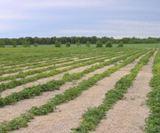Strawberry
Renovation
Renovation is the management process of regenerating a strawberry planting of June bearers after harvest to keep the planting for an additional cropping year.
The cost of renovation is much less than establishing a new planting. Some growers keep a field in production for three, four or even more years.
Renovation is most successful if the plants are vigorous. Renovation is not used on plantings in the establishment year or on day neutrals.

Once the last picking is over, fields of June bearers should be renovated immediately to attain maximum regrowth in the short fall season. A week?s delay may well mean a greatly reduced crop the following year.
Strawberry plants tend to enter a stage of low activity toward the end of harvest. Renovation stimulates renewed growth and eliminates weak plants which compete for fertilizer, moisture and light.
How to Renovate
- After the last picking, apply at least 50 lb/acre (56 kg/ha) of each macronutrient (nitrogen, phosphorus and potassium). This can be done by applying 500 lb/acre (560 kg/ha) of 10-10-10 or 300 lb/acre (336 kg/ha) of 17-17-17 directly over the rows. This could be followed by a 25 lb/acre (28 kg/ha) application of actual nitrogen in mid August. Higher levels of nitrogen may be required on lighter soils that have been exposed to nutrient leaching by excessive rainfall or supplemental irrigation.
- Mow the tops of the plants to remove old leaves without cutting the new expanding growth. This usually occurs at a height of 1 to 2 in. (2.5 to 5 cm) above the crowns. Some growers have observed negative effects from mowing. This can be caused by an unusually long harvest period, which leaves less time for the development of a new, full-foliage canopy, or by mowing too close to the crowns, especially during abnormally hot weather. One advantage of mowing is the development of a younger, more efficient leaf canopy. This rejuvenated canopy is more effective for "recharging" the plant energy systems for fruit formation and the over wintering food reserve buildup. Mowing also offers disease and insect control benefits, especially if the old leaves are removed from the row.
- Use a coulter on either side of the row, followed by raking to move unrooted and weakly-rooted plants into the aisle. This practice prevents plants from encroaching on the aisle way. Spacing of plants with mature crowns should be 15 to 33 cm (6 to 9 in.) Apart in the matted row.
- Applying recommended herbicides at renovation as an overall or banded spray can slow down the regeneration of the strawberry plant. Some hand weeding or herbicide spot treatment may be preferred to minimize plant stress.
- Irrigate thoroughly and repeat as necessary to maintain sufficient moisture for vigorous growth. Apply nitrogen in early to mid-August. Apply a post-emergent herbicide as required. Mulch for winter protection in mid to late October.

